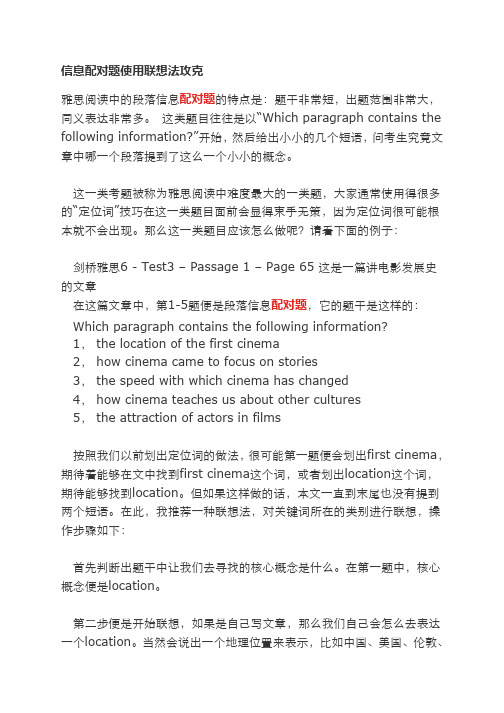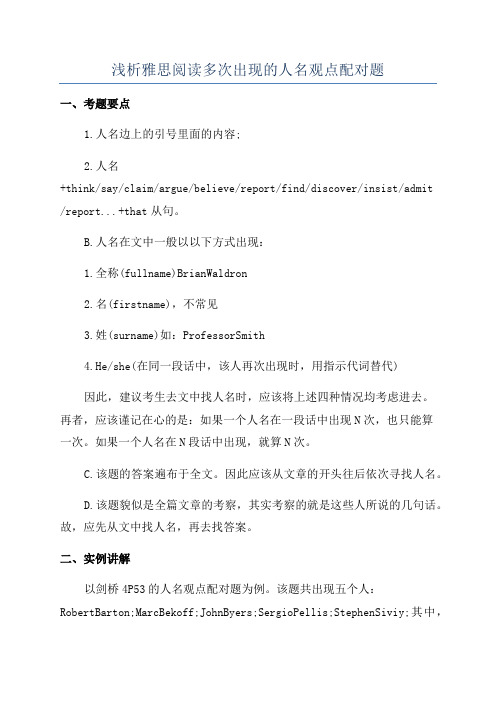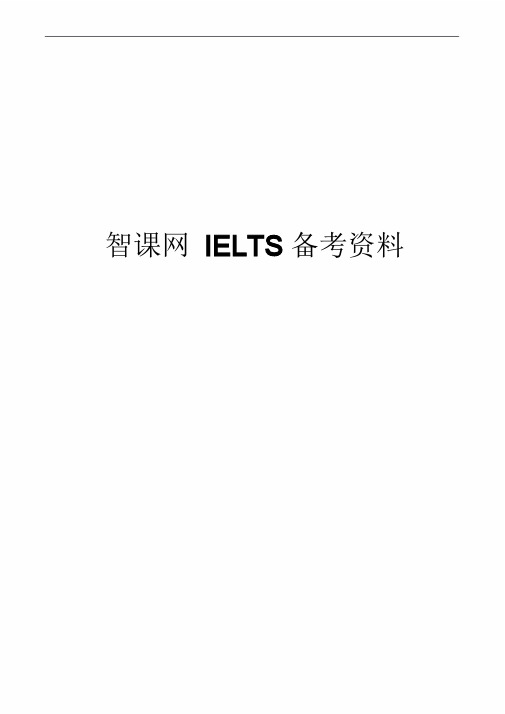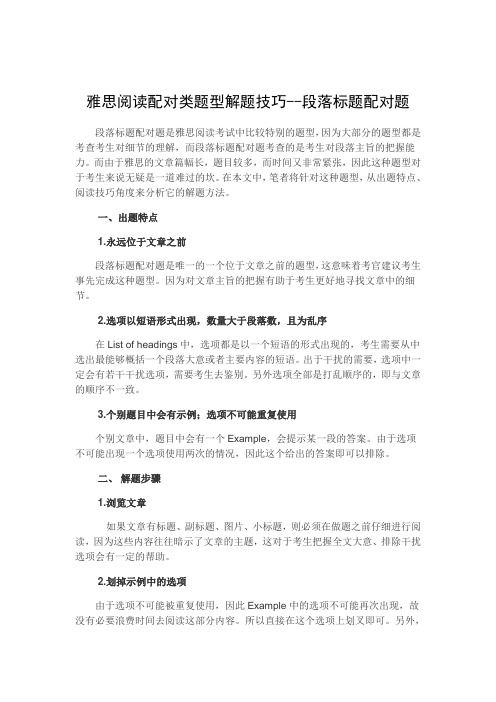雅思阅读-配对题练习
【精编】雅思阅读配对题-精心整理

B Research has shown that there is genetic or inherited element to handedness. But while lefthandedness tends to run in families, neither left nor right handlers will automatically produce off-spring with the same handedness; in fact about 6 per cent of children with two right-handed parents will be left-handed. However, among two left-handed parents, perhaps 40 per cent of the children will also be left-handed. With one right and one lefthanded parent, 15 to 20 per cent of the offspring will be left-handed. Even among identical twins who have exactly the same genes, one in six pairs will differ in their handedness.
第八讲:雅思阅读配 对题
越努力越幸运
一、形式:三部分组成
• 题目要求、选项的集合、题目的集合
越努力越幸运
二、特点:难以捉摸
• 大多数是细节信息(段落配信息题除外) • 有乱序分布
越努力越幸运
三、分类
• 配对一方是特殊定位词
• 人名配观点
雅思阅读高分解题技巧之配对题

雅思阅读高分解题技巧之配对题(上)所属:沪江网难度:困难来源:新浪博客评论:1 划词:已禁用收藏编辑点评:配对类题型有很多种,常见的种类有: 1. 人名- 观点; 2. 地名- 描述; 3. 句子- 句子;4. 分类题;5. 段落- 标题;6. 段落- 细节。
其中前三种做题方法比较类似,而后两种相对较复杂。
下面为大家介绍前四种题型的做题方法。
配对题的解题步骤和方法一、划出句子中的关键词很多考生习惯于冲上来首先去找定位词,但是这种方法是不对的。
因为在有专有名词的配对题里,定位词是显而易见的,寻找之前看一下即可;而在句子配对题中,因为题干是按顺序出题的,所以应当先把选项读完,再看题干。
由于人的短期记忆能力是有限的,在短时间内无法记下所有的句子。
因此需要寻找选项中的一些在最大程度上概括整个选项的关键词。
我们还是以一道句子配对题为例,看来一下关键词的划法(剑 5 Test 2 Q24-27 ):A、react to their own thoughtsB、helped create language in humansC、respond instantly to whatever is happeningD、may provide valuable information about the operation of the brain.E、cope with difficult situations.F、relate to a person’s subjective views.G、led our ancestors to smile and then laugh.二、找出定位词既然这些配对题和判断、填空、选择等题目一样考察的是考生对于细节的理解,那么这就决定了其做题方法:定位—阅读—做题。
在读完选项之后,接下来就是寻找定位词。
对于人名- 观点和地名- 描述这两种题目来说,定位词就是人名和地名。
而对于句子配对题来说,定位词相对比较难找。
雅思阅读配对题目(Matching)攻克

信息配对题使用联想法攻克雅思阅读中的段落信息配对题的特点是:题干非常短,出题范围非常大,同义表达非常多。
这类题目往往是以―Which paragraph contains the following information?‖开始,然后给出小小的几个短语,问考生究竟文章中哪一个段落提到了这么一个小小的概念。
这一类考题被称为雅思阅读中难度最大的一类题,大家通常使用得很多的―定位词‖技巧在这一类题目面前会显得束手无策,因为定位词很可能根本就不会出现。
那么这一类题目应该怎么做呢?请看下面的例子:剑桥雅思6 - Test3 – Passage 1 – Page 65 这是一篇讲电影发展史的文章在这篇文章中,第1-5题便是段落信息配对题,它的题干是这样的:Which paragraph contains the following information?1, the location of the first cinema2, how cinema came to focus on stories3, the speed with which cinema has changed4, how cinema teaches us about other cultures5, the attraction of actors in films按照我们以前划出定位词的做法,很可能第一题便会划出first cinema,期待着能够在文中找到first cinema这个词,或者划出location这个词,期待能够找到location。
但如果这样做的话,本文一直到末尾也没有提到两个短语。
在此,我推荐一种联想法,对关键词所在的类别进行联想,操作步骤如下:首先判断出题干中让我们去寻找的核心概念是什么。
在第一题中,核心概念便是location。
第二步便是开始联想,如果是自己写文章,那么我们自己会怎么去表达一个location。
雅思培训丨雅思阅读段落大意匹配题

雅思培训丨雅思阅读段落大意匹配题朗阁雅思培训中心宋媛婧在众多雅思阅读题型中,段落大意匹配题(List of Headings)一向是许多烤鸭的“老大难”问题。
而且根据笔者的教学经验,发现这一题型经常会出现“两极分化”的现象:有些学生能够很好地应对,正确率也颇高;而有些学生一做就几乎全错,出现匹配题惯有的“连锁反应”。
段落大意匹配题真的有那么难吗?今天朗阁雅思培训中心的雅思专家就来给大家从浅入深地了解这一题型的特点及解法。
一、出题形式考题中给出一个选项方框,框中列出若干以小写罗马数字为编号的名词性短语或短句,如“Effects of initial MIRTP measures”,方框下方为题干,给出用英文字母为编号的段落名,如“Paragraph A”,有时也会将几段内容合并在一起,以“Section”为编号。
该题型要求考生根据文章,在方框中选出合适的选项作为出题段落或章节的标题。
重点考察学生段落大意的概括能力和中心主题句的寻找能力。
二、题型特点笔者归纳了以下几条:1.该题型出现在正文前面,要特别注意不要漏做。
2.每个标题只使用一次,不重复选择。
3.一般来说,heading的数目比题量数目多出2-3个,这些干扰项中,可能会出现与正确选项非常接近的情况,考生一定要找出差异,加以辨别。
4.有些考题中会给出例子,例子中已经选过的选项可以直接排除(但建议考生要把排除的选项看一遍,因为往往给出的例子为首段的概括内容,我们可以通过这些排除的heading了解到文章的大体话题)。
5.注意给出的出题段落,不是所有段标题都覆盖全文(如剑6的Advantages of publictransport)。
三、考查技能1. 逻辑关联能力很多题材与体裁鲜明的文章,我们通过观察标题、副标题、图片了解文章的主题之后,对于文章的行文思路已经可以做出大致的预判。
再通过阅读和分析所有的heading,推测它们之间的前后逻辑顺序,脑中就应该形成了基本的逻辑链。
浅析雅思阅读多次出现的人名观点配对题

浅析雅思阅读多次出现的人名观点配对题一、考题要点1.人名边上的引号里面的内容;2.人名+think/say/claim/argue/believe/report/find/discover/insist/admit/report...+that从句。
B.人名在文中一般以以下方式出现:1.全称(fullname)BrianWaldron2.名(firstname),不常见3.姓(surname)如:ProfessorSmith4.He/she(在同一段话中,该人再次出现时,用指示代词替代)因此,建议考生去文中找人名时,应该将上述四种情况均考虑进去。
再者,应该谨记在心的是:如果一个人名在一段话中出现N次,也只能算一次。
如果一个人名在N段话中出现,就算N次。
C.该题的答案遍布于全文。
因此应该从文章的开头往后依次寻找人名。
D.该题貌似是全篇文章的考察,其实考察的就是这些人所说的几句话。
故,应先从文中找人名,再去找答案。
二、实例讲解以剑桥4P53的人名观点配对题为例。
该题共出现五个人:RobertBarton;MarcBekoff;JohnByers;SergioPellis;StephenSiviy;其中,RobertBarton;SergioPellis;StephenSiviy仅出现一次。
MarcBekoff在文中出现两次;JohnByers出现了三次。
这样,我们先解决出现一次的人名,然后去处理出现两次的人名,处理出现三次的人名。
(一)处理出现一次的人名在这三个出现一次的人名中,SergioPellis是在文中个出现的人名,现在以此为例进行分析讲解。
我们将个句子进行简化:首先将时间短语删去,将该人的单位删去。
SergioPellisreportedthatthereisastrongpositivelinkbetweenbra insizeandplayfulnessamongmammalsingeneral(可删).这里的positivelink是指正相关,或成正比。
雅思阅读真题附答案(完整版)

智课网IELTS备考资料雅思阅读真题附答案(完整版)摘要:雅思阅读真题是考生练习雅思阅读的必备资料。
不少考生在网上寻求雅思阅读真题,今天小编汇总了里面雅思阅读真题附答案版,方便考生复习。
雅思阅读真题是历年雅思考试中出现的雅思阅读题目,练习雅思阅读真题对于考生提升雅思阅读答题能力有很大的帮助。
小编整理了历年雅思阅读真题附答案,帮助考生复习雅思阅读。
雅思阅读真题附答案版(部分内容):题型:人名观点配对他在寻找古老的湖泊,这名Mungo 女子是被火葬的 A持怀疑态度的教授对一些化石的DNA 进行了可靠的分析 E教授测定的人的年龄要比62000 年前年轻的多的结果 A确定Mungo 人的年龄,争议了澳大利亚人的起源 B在澳洲,研究小组谁先恢复生物的证据,发现尼安德特人 C年代的支持者认为澳大利亚巨型动物的灭绝是由于古代人类狩猎造成的 D多区域的解释已经被提出,而不是坚持认为单一的起源 B史前人类活动导致气候变化而不是巨型动物的灭绝 A判断题Mungo 湖仍然为考古学家提供了图解说明人类活动的证据True在Mungo 湖发现Mungo 使用的武器Not givenMungo 人是在复杂的文化世界上已知最古老的考古证据之一,如埋葬仪式TrueMungo 男人和女人的骨架是被发现在同一年False澳大利亚教授使用古老的研究方法对“走出非洲”支持者的批判Not given以上就是关于雅思阅读真题附答案的相关汇总,考生可以通过上方下载完整版历年雅思阅读真题解析,提升资深雅思阅读能力。
相关字搜索:雅思阅读真题附答案人生中每一次对自己心灵的释惑,都是一种修行,都是一种成长。
相信我们常常用人生中的一些痛,换得人生的一份成熟与成长然⋯⋯生活里的每个人,都是我们的一面镜子,你给别人什世界上的幸福,没有一处不是来自用心经营和珍惜。
当你一味的去挑剔指责别人的时候,有没有反思过是否?假如你的心太过自我不懂得经营和善待,不懂得尊重他人感受,那你永远也不会获得真和幸福 ⋯ ⋯人生就像一场旅行,我们所行走的每一步都是在丰富生命的意义。
2009年1月17日雅思阅读机经及参考答案

2009年1月17日雅思阅读机经及参考答案Passage 1文章标题Tickling and laughter文章大意是说抚摸和笑之间的关系什么的,人们对痒的敏感度不同,痒的身体部位不同,原因还不得而知。
题目类型Matching(段落信息配对)SummaryMatching(人物观点配对)参考答案Matching:第一大题是写得段落包含信息这一大题中的, 第一小题和最后一小题我记得都选择E,Summary:最后的两个填空很简单,就是文中的原词:cortex(类似),第二个记不得了Matching:当一个人被告知要被tickle的时候,脑子里会产生一个什么东西不让你笑有讲几个人其中有达尔文和几个科学家的观点 matchingPassage 2文章标题A Famous Management scholar 彼得德鲁克文章大意讲一个人,他是管理学的开创者(pioneer of the business management),第一个把管理学从经济领域扩大到其他行业的。
文中大篇幅的讲了管理者应该转变观念,视员工为knowledge source 而不是work machine。
管理者和员工不仅仅是老板和雇员的关系,而是更介于其中的一种,有一个词不会翻译, 还有提到管理者应该来制定长远计划,而员工应该有自由来决定用什么方法去实现题目类HeadingY/N/NG (3) 多选型参考答案List of headings:答案一:第一段总述了一下他的成就,写过n本书,影响遍布各个角落第二段他早期的三本书及大致内容,其中有一本现在还在印刷第三段写此人的几个重要思想, 其中有好多他的经典理论第四段一些人的针对性批评第五段这些批评有的对有的不对,举了例子来辩护后面还有一段/2段,不太记得了答案二:第一个是选择他的著作流行和对世界的广泛影响;第二个是他早期的publishing;第三个是写BLALANCED MANAGEMENT;第四个是PRO AND CON;第五个是find fault with DRUKER;第六个是the changing role of the employee.(不太肯定的有一个)Y/N/NG:1. 此人认为员工和老板应该有一样的地位 (yes/ NG 不详)2. 第二题:政府能决定经济(NG)3. 政治家无法控制经济发展这一项选择NG多选:1,哪两项是他的观点貌似是CD 选项是他认为管理学应该超出管理的范围;员工管理要平衡(大意,记不清了)2,别人批评他哪两点貌似是AD 选项是批评者认为他的研究领域太广泛了,不专;另外一个记不清了Passage 3文章标题Tortoise and turtles文章大意有点难,是说动物从海里---陆地----海里的过程。
雅思阅读配对类题型解题技巧--段落标题配对题

雅思阅读配对类题型解题技巧--段落标题配对题段落标题配对题是雅思阅读考试中比较特别的题型,因为大部分的题型都是考查考生对细节的理解,而段落标题配对题考查的是考生对段落主旨的把握能力。
而由于雅思的文章篇幅长,题目较多,而时间又非常紧张,因此这种题型对于考生来说无疑是一道难过的坎。
在本文中,笔者将针对这种题型,从出题特点、阅读技巧角度来分析它的解题方法。
一、出题特点1.永远位于文章之前段落标题配对题是唯一的一个位于文章之前的题型,这意味着考官建议考生事先完成这种题型。
因为对文章主旨的把握有助于考生更好地寻找文章中的细节。
2.选项以短语形式出现,数量大于段落数,且为乱序在List of headings中,选项都是以一个短语的形式出现的,考生需要从中选出最能够概括一个段落大意或者主要内容的短语。
出于干扰的需要,选项中一定会有若干干扰选项,需要考生去鉴别。
另外选项全部是打乱顺序的,即与文章的顺序不一致。
3.个别题目中会有示例;选项不可能重复使用个别文章中,题目中会有一个Example,会提示某一段的答案。
由于选项不可能出现一个选项使用两次的情况,因此这个给出的答案即可以排除。
二、解题步骤1.浏览文章如果文章有标题、副标题、图片、小标题,则必须在做题之前仔细进行阅读,因为这些内容往往暗示了文章的主题,这对于考生把握全文大意、排除干扰选项会有一定的帮助。
2.划掉示例中的选项由于选项不可能被重复使用,因此Example中的选项不可能再次出现,故没有必要浪费时间去阅读这部分内容。
所以直接在这个选项上划叉即可。
另外,对于某些记忆力不好的考生来说,也可以把这个选项所对应的段落做上记号,以免误读从而浪费时间。
3.阅读所有选项,标出关键词由于选项是乱序,因此如果先读文章再去找选项,就有可能出现每读一个段落,就要通读一遍所有的选项这样的问题,最后发现把所有的选项读了数遍。
因此,建议考生在阅读文章之前就先把所有选项仔细阅读一遍,并且划出关键词以便记忆。
- 1、下载文档前请自行甄别文档内容的完整性,平台不提供额外的编辑、内容补充、找答案等附加服务。
- 2、"仅部分预览"的文档,不可在线预览部分如存在完整性等问题,可反馈申请退款(可完整预览的文档不适用该条件!)。
- 3、如文档侵犯您的权益,请联系客服反馈,我们会尽快为您处理(人工客服工作时间:9:00-18:30)。
配对练习1A Why do humans, virtually alone among all animal species, display a distinct left or righthandedness? Not even our closest relatives among the apes possess such decided lateral asymmetry, as psychologists call it. Yet about 90 per cent of every human population that has ever lived appears to have been right-handed. Professor Bryan Turner at Deacon University has studied the research literature on left-handedness and found that handedness goes with sidedness. So nine out of ten people are right-handed and eight are right-footed. He noted that this distinctive asymmetry in the human population is itself systematic. Humans think in categories: black and white, up and down, left and right. It's a system of signs that enables us to categories phenomena that are essentially ambiguous.B Research has shown that there is genetic or inherited element to handedness. But whileleft-handedness tends to run in families, neither left nor right handlers will automatically produce off-spring with the same handedness; in fact about 6 per cent of children with two right-handed parents will be left-handed. However, among two left-handed parents, perhaps 40 per cent of the children will also be left-handed. With one right and one left-handed parent, 15 to 20 per cent of the offspring will be left-handed. Even among identical twins who have exactly the same genes, one in six pairs will differ in their handedness.C What then makes people left-handed if it is not simply genetic? Other factors must be at workand researchers have turned to the brain for clues. In the 1860s the French surgeon and anthropologist, Dr Paul Boca,made the remarkable finding that patients who had lost their powers of speech as a result of a stroke (a blood clot in the brain) had paralysis of the right half of their body. He noted that since the left hemisphere of the brain controls the right half of the body, and vice versa, the brain damage must have been in the brain's left hemisphere, Psychologists now believe that among right handed people, probably 95 per cent have their language centre in the left hemisphere, while 5 per cent have right-sided language, Left-handers, however, do not show the reverse pattern but instead a majority also Some 30 per cent have right hemisphere language.D Dr Brinkman, a brain researcher at the Australian National University in Canberra, hassuggested that evolution of speech went with right-handed preference. According to Brinkman, as the brain evolved, one side became specialized for fine control of movement (necessary for producing speech) and along with this evolution came right-hand preference. According to Brinkman, most left-handers have left hemisphere dominance but also some capacity in the right hemisphere. She has observed that if a left-handed person is brain-damaged in the left hemisphere, the recovery of speech is quite often better and this is explained by the fact that left-handers have a more bilateral speech function.E In her studies of macaque monkeys, Brinkman has noticed that primates (monkeys) seem tolearn a hand preference from their mother in the first year of life but this could be one hand or the other. In humans, however, the specialization in function of the two hemispheres results in anatomical differences; areas that are involved with the production of speech are usually larger on the left side than on the right. Since monkeys have not acquired the art of speech, one would not expect to see such a variation but Brinkman claims to have discovered a trend in monkeys towards the asymmetry that is evident in the human brain.F Two American researchers, Geschwind and Galaburda, studied the brains of human embryosand discovered that the left-right asymmetry exists before birth. But as the brain develops, anumber of things can affect it. Every brain is initially female in its organisation and it only becomes a male brain when the male fetus begins to secrete hormones. Geschwind and Galaburda knew that different parts of the brain mature at different rates; the right hemisphere develops first, then the left. Moreover, a girl's brain develops somewhat faster than that of a boy.So, if something happens to the brain's development during pregnancy, it is more likely to be affected in a male and the hemisphere more likely to be involved is the left. The brain may become less liberalized and this in turn could result in left-handedness and the development of certain superior skills that have their origins in the left hemisphere such as logic, rationality and abstraction. It should be no surprise then that among mathematicians and architects, left-handers tend to be more common and there are more left-handed males than females.G The results of this research may be some consolation to left-handers who have for centurieslived in a world designed to suit right-handed people. However, what is alarming, according to Mr. Charles Moore, a writer and journalist, is the way the word `right' reinforces its own virtue.Subliminally he says, language tells people to think that anything on the right can be trusted while anything on the left is dangerous or even sinister. We speak of left-handed compliments and according to Moore, `it is no coincidence that left-hand, often develop a stammer as they are robbed of their freedom of speech'. However, as more research is undertaken on the causes of left handedness, attitudes towards left-handed people are gradually changing for the better.Indeed when the champion tennis player Indeed when the champion tennis player Ivan Lend was asked what the single thing improve his game, he said he would like to become a left-hander.•Questions 1-7•Use the information in the text to match the people (listed A-E) with the opinions (listed 1-7) below. Write the appropriate letter (A-E) in boxes 1-7 on your answer sheet. Some people match more than one opinion.• A Dr Boca• B Dr Brinkman• C Geschwind and Galaburda• D Charles Moore• E Professor Turner1.Human beings started to show a preference for right-handedness when they first developedlanguage.2.Society is prejudiced against left-handed people.3.Boys are more likely to be left-handed.4.After a stroke, left-handed people recover their speech more quickly than right-handedpeople.5.People who suffer strokes on the left side of the brain usually lose their power of speech.6.The two sides of the brain develop different functions before birth.7.Asymmetry is a common feature of the human body.配对练习2Obtaining Linguistic DataA Many procedures are available for obtaining data about a language. They range from a carefullyplanned, intensive field investigation in a foreign country to a casual introspection about one’s mother tongue carried out in an armchair at home.B In all cases, someone has to act as a source of language data – an informant. Informants are(ideally) native speakers of a language, who provide utterances for analysis and other kinds of information about the language (e.g. translations, comments about correctness, or judgements on usage). Often, when studying their mother tongue, linguists act as their own informants, judging the ambiguity, acceptability, or other properties of utterances against their ownintuitions. The convenience of this approach makes it widely used, and it is considered the norm in the generative approach to linguistics. But a linguist’s personal judgements are often uncertain, or disagree with the judgements of other linguists, at which point resource is needed to more object methods of enquiry, using non-linguists as informants. The later procedure is unavoidable when working on foreign languages, or child speech.C Many factors must be considered when selecting informants – whether one is working withsingle speakers (a common situation when languages have not been described before), two people interacting, small groups or large-scale samples. Age, sex, social background and other aspects of identity are important, as these factors are known to influence the kind of language used. The topic of conversation and the characteristics of the social setting (e.g. the level of formality) are also highly relevant, as are the personal qualities of the informants (e.g. their fluency and consistency). For larger studies, scrupulous attention has been paid to the sampling theory employed, and in all cases, decisions have to be made about the best investigativetechniques to use.D Today, researchers often tape-record informants. This enables the linguist’s claims about thelanguage to be checked, and provides a way of making those claims more accurate (‘difficult’ pieces of speech can be listened to repeatedly). But obtaining naturalistic, good-quality data is never easy. People talk abnormally when they know they are being recorded, and sound quality can be poor. A variety of tape-recording procedures have thus been devised to minimise the ‘observer’s paradox’ (how to observe the way people behave when they are not beingobserved). Some recordings are made without the speakers being aware of the fact – aprocedure that obtains very natural data, though ethical objections must be anticipated.Alternatively, attempts can be made to make the speaker forget about the recording, such as keeping the tape recorder out of sight, or using radio microphones. A useful technique is to introduce a topic that quickly involves the speaker, and stimulates a natural language style (e.g.asking older informants about how times have changed in their locality).E An audio tape recording does not solve all the linguist’s problems, howev er. Speech is oftenunclear and ambiguous. Where possible, therefore, the recording has to be supplements by the observer’s written comments on the non-verbal behaviour of the participants, and about the context in general. A facial expression, for example, can dramatically alter the meaning of what is said. Video recordings avoid these problems to a large extent, but even they have limitations (the camera cannot be everywhere), and transcription always benefits from any additionalcommentary provided by an observer.F Linguists also make great use of structured sessions, in which they systematically ask theirinformants for utterances that describe certain actions, objects or behavious. With a bilingual informant, or though use of an interpreter, it is possib le to use translation technique (‘How do you say table in your language?’). A large number of points can be covered in a short time, using interview work-sheets and questionnaires. Often, the researcher wishes to obtaininformation about just a single variable, in which case a restricted set of questions may be used:a particular feature of pronunciation, for example, can be elicited by asking the informant to saya restricted set of words. There are also several direct methods of elicitation, such as askinginformants to fill in the blanks in a substitution frame (e.g. 'I ___ see a car.'), or feeding them the wrong stimulus for correction (‘Is it possible to say I no can see?’).G A representative sample of language, complied for the purpose of linguistic analysis, is knownas a corpus. A corpus enables the linguist to make unbiased statements about frequency ofusage, and it provides accessible data for the use of different researchers. Its range and size are variable. Some corpora attempt to cover the language as a whole, taking extracts from many kinds of text; others are extremely selective, providing a collection of material that deals only with a particular linguistic feature. The size of the corpus depends on practical factors, such as the time available to collect, process and store the data: it can take up to several hours toprovide an accurate transcription of a few minutes of speech. Sometimes a small sample of data will be enough to decide a linguistic hypothesis; by contrast, corpora in major research projects can total millions of words. An important principle is that all corpora, whatever their size, are inevitably limited in their coverage, and always need to be supplemented by data derived from the intuitions of native speakers of the language, though either introspection orexperimentation.•Question 27-31Reading Passage 3 has 7 paragraphs labelled A-G.Which paragraph contains the following information?Write the correct answer A-G into boxes 27-31 on the answer sheet.NB You may use any letter more than once.27. The effect of recording on the way people talk.28. The importance of taking note on body language.29. The fact that language is influenced by social situation.30. How informants can be helped to be less self-conscious.31. Various methods that can be used to generate specific data.。
